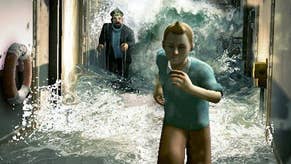The Double-A Team: Brisk and stylish, The Adventures of Tintin is a film tie-in to cherish
Acting the goat?!
The Double-A Team is a newish feature series honouring the unpretentious, mid-budget, gimmicky commercial action games that no-one seems to make any more.
Check out our archive of Double-A pieces here!
Film tie-ins, with a few legendary exceptions, are all members of the Double-A Team. The budgets will not do, in most cases, but also the spark of inspiration is borrowed, second-hand. Someone had a great idea for a film - hopefully - but that's not the same as having a great idea for a game. Then there's the question of fitting it into the timeline. Do you try to restage the film's big sequences, or do you Rosencrantz and Guildenstern your way through the plot's absences, jumping from one off-screen moment to the next?
A Double-A effort that really nails the spirit of the movie is a rare wonder, and it's even rarer to find a Double-A effort that could stand on its own. Enter The Adventures of Tintin: The Secret of the Unicorn. It's a Ubisoft game from just before Ubisoft games were swept away in incremental hub-and-spoke development, each one borrowing and building on the UI, the towers, the eagle-drones and open worlds of the last. It's a Ubisoft game where developers have looked at the property and thought: how can we make this sing?
It helps that the property is Tintin, even if it's Tintin seen through the slightly spooky lens of Spielberg's CGI film. The film's not bad - it's actually a clever mash-up of The Secret of the Unicorn and the Crab with the Golden Claws, and to watch it is to play a sort of hidden-object game as decades of Tintin references and in-jokes are scattered over every busy frame. But the film looks quite weird. Tintin is at best haunted - too many different people have tinkered with his face. The mo-cap is as creepy as it always is. You sort of wish they'd just gone 2D with the whole thing.
With the game, they did. Not 2D in terms of the art - cor, wouldn't that have been a thing - but 2D with the best levels, in which they sort of Dolls-Houseify a bunch of locations in which you work your way through, puzzle-platforming and engaging in a little light combat. Nothing's too tricky to get a handle on, but the whole thing has that secret Tintin magic: it's brisk. If Tintin's creator had a signature move it's that little extended coil of ink that suggests a car or a person is in movement, really hoofing it. Nothing takes too long in a globe-trotting adventure that is always wrapped up in 62 pages. And so it is here: levels are short and busy and move at a clip. There are lots of lovely ideas, and everywhere you look there's a pose or a bit of incidental detailing that fans of the books will recognise.
Let's ignore the 3D stuff, which is not the game at its best, and leave with rosy memories of the co-op mode, which takes place in Haddock's dreams. Nobody illustrated dreams quite like Herge. Nobody else is as good at the little incremental changes that dreams drop on you with each passing moment. To let you lose in these dreams, and to build puzzles around dream logic, is a lovely, lovely move. This isn't just a game with Tintin in it, then. It's a game that truly gets Tintin. And it's wonderful.










.png?width=291&height=164&fit=crop&quality=80&format=jpg&auto=webp)
